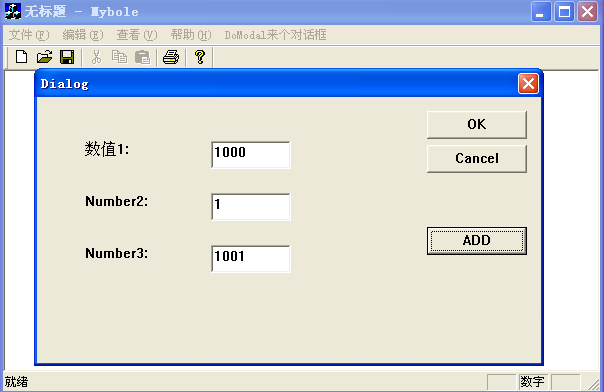孙鑫VC++深入详解:Lesson7 Part1---模态对话框,非模态对话框,静态文本控件的访问
知识点: 在MFC中要对一个资源,就应该先为该资源创建一个关联的类,通过类的对象来操作该资源
//----创建模态对话框
CTestDlg dlg;dlg.DoModal();
//----创建非模态对话框
CTestDlg *pDlg=new CTestDlg();
pDlg->Create(IDD_DIALOG1,this);
pDlg->ShowWindow(SW_SHOW);
//------静态文本控件的访问
(1)改变控件的ID
(2)Style中勾选Notify
(3)用Cwnd* GetDlgItem(int nID) const 函数获得指向控件的指针
(4)用GetWindowText(str),SetWindowText(str)函数.
//---
// TestDlg.cpp : implementation file
//
#include "stdafx.h"
#include "Mybole.h"
#include "TestDlg.h"
#ifdef _DEBUG
#define new DEBUG_NEW
#undef THIS_FILE
static char THIS_FILE[] = __FILE__;
#endif
/////////////////////////////////////////////////////////////////////////////
// CTestDlg dialog
//构造函数,用基类CDialog构造函数传入IDD,这个IDD就是IDD_DIALOG1,IDD在TestDlg.h中定义的.
CTestDlg::CTestDlg(CWnd* pParent /*=NULL*/)
: CDialog(CTestDlg::IDD, pParent)
{
//{{AFX_DATA_INIT(CTestDlg)
// NOTE: the ClassWizard will add member initialization here
//}}AFX_DATA_INIT
m_bIsCreate = false;
}
void CTestDlg::DoDataExchange(CDataExchange* pDX)
{
CDialog::DoDataExchange(pDX);
//{{AFX_DATA_MAP(CTestDlg)
// NOTE: the ClassWizard will add DDX and DDV calls here
//}}AFX_DATA_MAP
}
BEGIN_MESSAGE_MAP(CTestDlg, CDialog)
//{{AFX_MSG_MAP(CTestDlg)
ON_BN_CLICKED(ID_BTN_ADD, OnBtnAdd)
ON_BN_CLICKED(IDC_NUMBER1, OnNumber1)
//}}AFX_MSG_MAP
END_MESSAGE_MAP()
/////////////////////////////////////////////////////////////////////////////
// CTestDlg message handlers
void CTestDlg::OnBtnAdd()
{
// TODO: Add your control notification handler code here
//--- 创建按钮
/*
static bool m_bIsCreate = false;
if(m_bIsCreate==false)
{
m_btn.Create("微信",BS_DEFPUSHBUTTON|WS_VISIBLE|WS_CHILD,CRect(0,0,100,100),this,123);
m_bIsCreate = true;
}
else
{
m_btn.DestroyWindow();
m_bIsCreate = false;
}
*/
//---利用m_btn对象中的成员m_hWnd来判断按钮是否创建.
/*
if(m_btn.m_hWnd==NULL)
m_btn.Create("微信",BS_DEFPUSHBUTTON|WS_VISIBLE|WS_CHILD,CRect(0,0,100,100),this,123);
else m_btn.DestroyWindow();
*/
//------ 加法
int num1,num2,num3;
char ch1[10],ch2[10],ch3[10];
GetDlgItem(IDC_EDIT1)->GetWindowText(ch1,10);
GetDlgItem(IDC_EDIT2)->GetWindowText(ch2,10);
num1 = atoi(ch1);
num2 =atoi(ch2);
num3 = num1+num2;
itoa(num3,ch3,10);
GetDlgItem(IDC_EDIT3)->SetWindowText(ch3);
}
// -----静态文本的访问
void CTestDlg::OnNumber1()
{
// TODO: Add your control notification handler code here
CString str;
if(GetDlgItem(IDC_NUMBER1)->GetWindowText(str),str="Number1:")
{
GetDlgItem(IDC_NUMBER1)->SetWindowText("数值1:");
}
else
{
GetDlgItem(IDC_NUMBER1)->SetWindowText("Number1:");
}
}
//---
